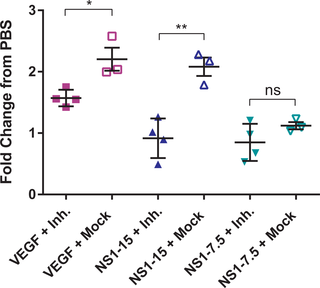PLoS Pathogens ( IF 6.7 ) Pub Date : 2017-11-09 , DOI: 10.1371/journal.ppat.1006673 Dustin R. Glasner , Kalani Ratnasiri , Henry Puerta-Guardo , Diego A. Espinosa , P. Robert Beatty , Eva Harris

|
Dengue virus (DENV) is the most prevalent, medically important mosquito-borne virus. Disease ranges from uncomplicated dengue to life-threatening disease, characterized by endothelial dysfunction and vascular leakage. Previously, we demonstrated that DENV nonstructural protein 1 (NS1) induces endothelial hyperpermeability in a systemic mouse model and human pulmonary endothelial cells, where NS1 disrupts the endothelial glycocalyx-like layer. NS1 also triggers release of inflammatory cytokines from PBMCs via TLR4. Here, we examined the relative contributions of inflammatory mediators and endothelial cell-intrinsic pathways. In vivo, we demonstrated that DENV NS1 but not the closely-related West Nile virus NS1 triggers localized vascular leak in the dorsal dermis of wild-type C57BL/6 mice. In vitro, we showed that human dermal endothelial cells exposed to DENV NS1 do not produce inflammatory cytokines (TNF-α, IL-6, IL-8) and that blocking these cytokines does not affect DENV NS1-induced endothelial hyperpermeability. Further, we demonstrated that DENV NS1 induces vascular leak in TLR4- or TNF-α receptor-deficient mice at similar levels to wild-type animals. Finally, we blocked DENV NS1-induced vascular leak in vivo using inhibitors targeting molecules involved in glycocalyx disruption. Taken together, these data indicate that DENV NS1-induced endothelial cell-intrinsic vascular leak is independent of inflammatory cytokines but dependent on endothelial glycocalyx components.
中文翻译:

登革热病毒NS1细胞因子非依赖性血管渗漏取决于内皮糖萼成分
登革热病毒(DENV)是最普遍的,医学上重要的蚊媒病毒。疾病范围从单纯的登革热到威胁生命的疾病,其特征在于内皮功能障碍和血管渗漏。以前,我们证明DENV非结构蛋白1(NS1)在系统小鼠模型和人肺内皮细胞中诱导内皮过度通透性,其中NS1破坏了内皮糖萼样层。NS1还触发TLR4从PBMC释放炎性细胞因子。在这里,我们检查了炎症介质和内皮细胞内在途径的相对贡献。在体内,我们证明了DENV NS1而非紧密相关的西尼罗河病毒NS1触发了野生型C57BL / 6小鼠背部真皮中的局部血管渗漏。体外,我们发现暴露于DENV NS1的人真皮内皮细胞不会产生炎性细胞因子(TNF-α,IL-6,IL-8),并且阻断这些细胞因子不会影响DENV NS1诱导的内皮通透性。此外,我们证明了DENV NS1以与野生型动物相似的水平诱导TLR4或TNF-α受体缺陷型小鼠的血管渗漏。最后,我们使用靶向糖萼破坏的分子靶向抑制剂,阻断了DENV NS1诱导的体内血管渗漏。综上所述,这些数据表明DENV NS1诱导的内皮细胞内在性血管渗漏不依赖于炎性细胞因子,但依赖于内皮糖萼成分。



























 京公网安备 11010802027423号
京公网安备 11010802027423号